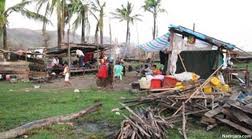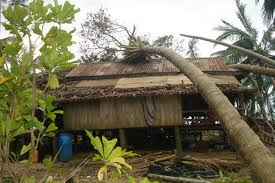I hear fear in the voice on the phone. “Strong winds started to blow at mid-day on March 14. Then, a storm hit at mid-night. The wind was very strong. It was terrifying. In a short time our boat collapsed under the force of the wind. The wind was causing chaos. Everything from our boat was floating in the water. I thought I would die.”
I hear fear in the voice on the phone.
“Strong winds started to blow at mid-day on March 14. Then, a storm hit at mid-night. The wind was very strong. It was terrifying. In a short time our boat collapsed under the force of the wind. The wind was causing chaos. Everything from our boat was floating in the water. I thought I would die.”
 This is the harrowing testimony of a fisherman from Phyar Pon Township, who was at sea when a storm hit the Ayawaddy and Yangon Region, of Burma, during a recent telephone interview with the Thailand-based Network Media Group.
This is the harrowing testimony of a fisherman from Phyar Pon Township, who was at sea when a storm hit the Ayawaddy and Yangon Region, of Burma, during a recent telephone interview with the Thailand-based Network Media Group.
“Because of the strong wind, some ships capsized and were destroyed and some rafts sunk. We could not help each other. Everybody had to survive on their own.”
According to a fisherman, from Kha Pyat Village, in Ayarwaddy Region, who was saved by a Thai fishing boat, many fishermen ended up in the sea and some were killed by the storm.
“About 10 fishermen held tightly to our raft. I saw some people with a collapsed bamboo raft floating in the sea. I think they died. Some people held plastic containers. Some people floated in the sea without holding anything. I could not say the exact number who died.”
Fishermen from Phyar Pon, Daydaye and La Putta townships in Ayawaddy Region floated in the sea for three days. Eventually, they were saved by Thai fishing boats.
Some environmentalists say the world faces the negative results of climate change more every year. Burma is no exception. In recent years, Burma has been hit by several major storms which have caused much suffering for many people.
According to Dr. Tun Lwin, a Burmese meteorologist, storms have hit Burma every year since 2006.
Tropical cyclone Mala hit Burma in 2006, cyclone Akash in 2007, cyclone Nargis in 2008, cyclone Bijli in 2009 and cyclone Giri in 2010.
Storms hit Burma’s costal area over 100 times in a 130 year period, from 1884 to 2010. Seventeen of the strongest storms caused severe damage, especially on the coast in Rakhine State, Western Burma.
Dr. Tun Lwin said 2011 will see even more storms wreak havoc in Burma.
According to a resident in Kyauk Phyu Town, authorities failed to warn the public before storms struck in the past.
“We don’t know what kind of storm will hit, how many miles per hour the winds are. They don’t give early warnings about a storm before it hits. In 2008, many people were killed by cyclone Nargis. This time (2010), many people were killed in Myay Pon Township too. Dead bodies were spread throughout Myay Pon after the Giri storm hit.”
According to a UN report, there was much damage in Rakhine State when Giri made landfall on October 22 and 23rd, 2010, with120 mile per hour winds. Over 100 people were killed and many buildings collapsed.
Over 170,000 people were affected by cyclone Giri.
As well as Myay Pon and Kyauk Phyu, Giri damaged Pauk-taw, Rambre, Mang-aung, Ann, Ponna Kyun, Sittawe and Minbyar in Rakhine State.
“Many buildings collapsed. Roofs of houses blew away. Schools also collapsed. Plants were up-rooted. Electricity posts fell down. Fishing boats were also damaged. Seawater flooded many paddy farms. Barriers holding back seawater in the town were also damaged,” according to a local resident from Myay Pon Township.
Witnesses say the area is still struggling to recover from damage.
“Everybody has faced many difficulties, especially farmers. They still cannot grow rice in their paddy fields because of flooding by sea- water and they lost all rice (seed). They need rice seed and the sea barriers repaired. If the situation keeps going like this, farmers cannot grow rice in their paddy fields next year,” a local resident said.
“Our fishing boats were destroyed. Shrimp ponds were also destroyed. Now we cannot do anything. In the past, we could cut fire-wood and bamboo to sell. We could grow cane,” a farmer from Myay Pon said.
Authorities did not provide essential relief supplies to the Giri storm victims. Moreover, individual donors, religious groups and NGOs had to get permission from authorities to help storm victims, according to a young Christian missionary who helped Giri victims in Kyauk Phyu.
Six months after cyclone Giri hit Burma, local people in Rakhine State still haven’t received adequate assistance even though International Emergency Relief Groups distributed essential supplies and emergency shelters. Therefore, these people continued to face hardships during the rainy season, according to a Kyauk Phyu resident.
 Cyclone Nargis, which hit Burma’s Ayawaddy and Yangon regions in May, 2008, caused the most damage and killed the highest number of people of any storm in Burma’s history. Over 100,000 people were killed and it caused $4.1 billion USD in damage.
Cyclone Nargis, which hit Burma’s Ayawaddy and Yangon regions in May, 2008, caused the most damage and killed the highest number of people of any storm in Burma’s history. Over 100,000 people were killed and it caused $4.1 billion USD in damage.
Burma has suffered from various kinds of natural disasters. According to the Asian Natural Disaster Management’s report about Burma, in Jun 2010, 70% of the damage caused by natural disasters was caused by fire, 10% by flood and storms and 9% by earthquakes and tsunamis, from 1996 to 2010.
Dr. Tun Lwin said the weather phenomena known as La Nina will impact the storm patterns affecting Burma this year.
“The momentum of La Nina still keeps going. So, I believe that this year will not have a summer because huge dense rain clouds are filling the sky. This means there will be strong winds, lightening and tornados. April 20th to May 20th is the first period of the storm season. We have to be concerned about storms during this period,” he told the Network Media Group in a recent interview.
Climate change is as a result of damage to the environment caused by human activity is a major contributor to the storm damage affecting regions of Burma, according to U Ohn, a Burmese environmentalist.
“It’s a man-made problem. The greed, anxiety and dissatisfaction of human beings cause many problems. This world provides enough natural resources but human beings are greedy. If people use the natural resources properly, it’s sufficient. However, because of greed, natural resources are damaged and the world’s climate has been changed. As a result, human beings face many troubles,” U Ohn said.
“In Burma, there are many mega projects which will damage the environment. These include deforestation to harvest timber, dam construction and mining,” said Ko Sai Sai, the Coordinator of the Burma River Network group.
Current and past regimes controlling Burma have used the popular cause of economic development as a means of looting the country’s natural resources for their own gain. And, they are widely criticized for ignoring the negative environmental impacts of their policies.
As Burma and other governments continue to abuse the environment to satisfy human greed, it seems that Burma’s vulnerable populations will continue to suffer the effects of severe storms.



